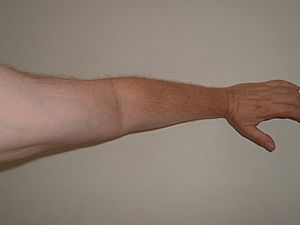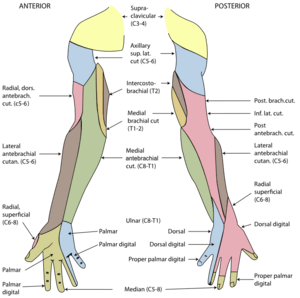Arm facts for kids
An arm is a limb. Most humans have two arms each, coming out of their body just below the neck. On the end of each arm is a hand. Humans use arms and hands to do things to other objects, this is called manipulation. The main purpose of the hand is to grasp objects. Some other primates have arms which they use to move around by holding onto trees or supporting themselves as they walk along the ground.
Anatomy
Bones
The humerus is one of the three long bones of the arm. It joins with the scapula at the shoulder joint and with the other long bones of the arm, the ulna and radius at the elbow joint. The elbow is the hinge joint between the end of the humerus and the ends of the radius and ulna. The humerus cannot be broken easily. Its strength allows it to handle loading up to 300 pounds (140 kg).
Muscles
The arm is divided by a fascial layer (known as lateral and medial intermuscular septa) separating the muscles into two osteofascial compartments: the anterior and the posterior compartments of the arm. The fascia merges with the periosteum (outer bone layer) of the humerus. The compartments contain muscles which are innervated by the same nerve and perform the same action.
Two other muscles are considered to be partially in the arm:
- The large deltoid muscle is considered to have part of its body in the anterior compartment. This muscle is the main abductor muscle of the upper limb and extends over the shoulder.
- The brachioradialis muscle originates in the arm but inserts into the forearm. This muscle is responsible for rotating the hand so its palm faces forward (supination).
Nerve supply
The musculocutaneous nerve, from C5, C6, C7, is the main supplier of muscles of the anterior compartment. It originates from the lateral cord of the brachial plexus of nerves. It pierces the coracobrachialis muscle and gives off branches to the muscle, as well as to brachialis and biceps brachii. It terminates as the anterior cutaneous nerve of the forearm.
The radial nerve, which is from the fifth cervical spinal nerve to the first thoracic spinal nerve, originates as the continuation of the posterior cord of the brachial plexus. This nerve enters the lower triangular space (an imaginary space bounded by, amongst others, the shaft of the humerus and the triceps brachii) of the arm and lies deep to the triceps brachii. Here it travels with the deep artery of the arm, which sits in the radial groove of the humerus. This fact is very important clinically as a fracture of the shaft of the bone here can cause lesions or even transections in the nerve.
Other nerves passing through give no supply to the arm. These include:
- The median nerve, nerve origin C5-T1, which is a branch of the lateral and medial cords of the brachial plexus. This nerve continues in the arm, travelling in a plane between the biceps and triceps muscles. At the cubital fossa, this nerve is deep to the pronator teres muscle and is the most medial structure in the fossa. The nerve passes into the forearm.
- The ulnar nerve, origin C8-T1, is a continuation of the medial cord of the brachial plexus. This nerve passes in the same plane as the median nerve, between the biceps and triceps muscles. At the elbow, this nerve travels posterior to the medial epicondyle of the humerus. This means that condylar fractures can cause lesion to this nerve.
Related pages
Images for kids
-
The arm, as can be seen here, formed one component of hieroglyphs






